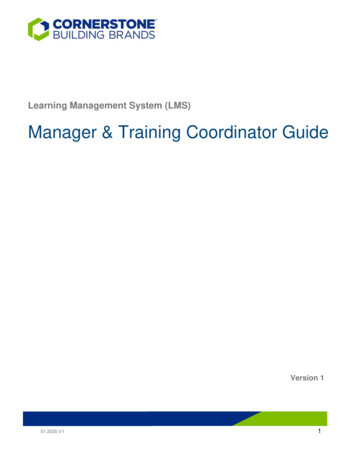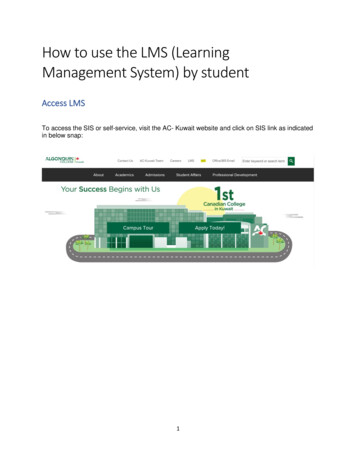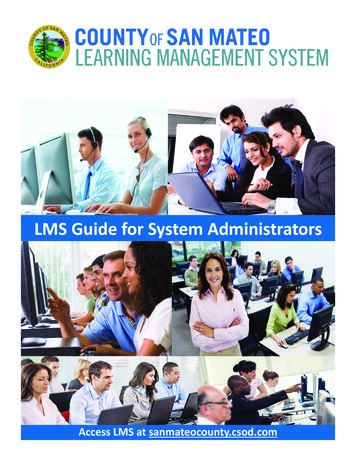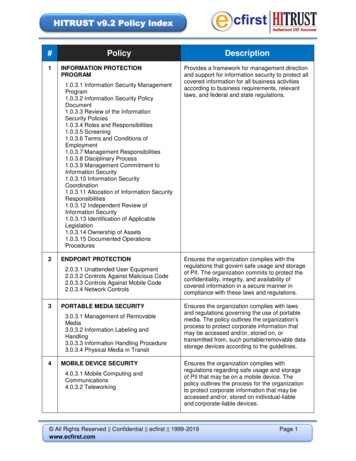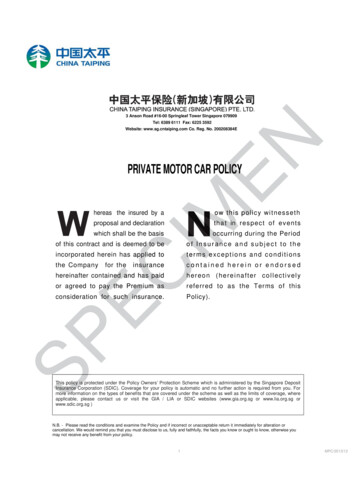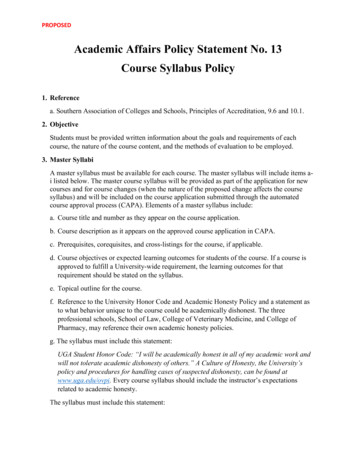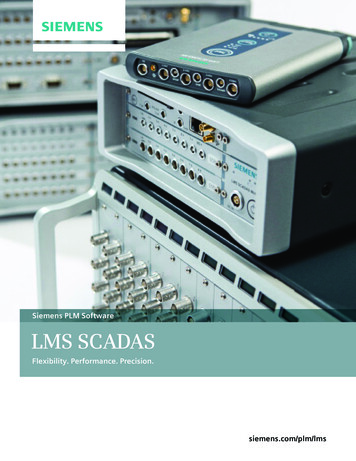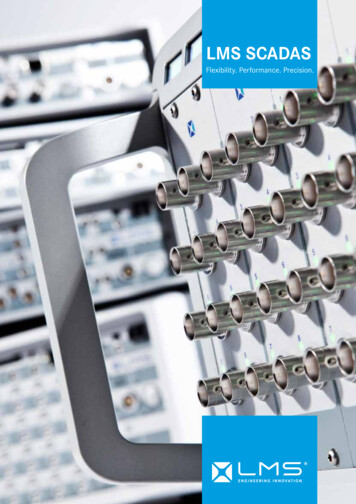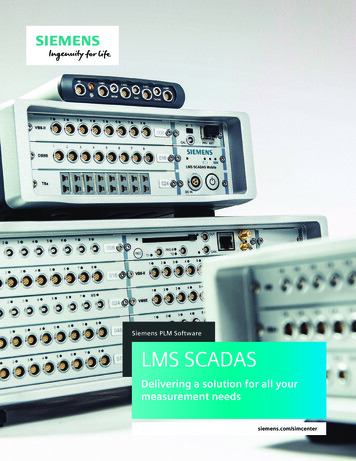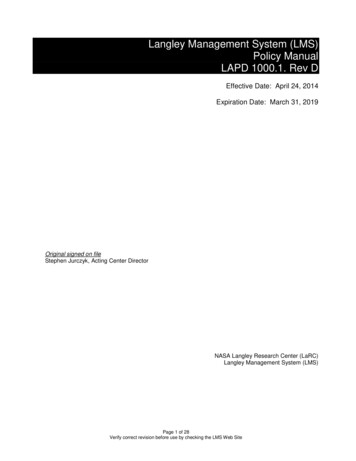
Transcription
Langley Management System (LMS)Policy ManualLAPD 1000.1. Rev DEffective Date: April 24, 2014Expiration Date: March 31, 2019Original signed on fileStephen Jurczyk, Acting Center DirectorNASA Langley Research Center (LaRC)Langley Management System (LMS)Page 1 of 28Verify correct revision before use by checking the LMS Web Site
April 24, 2014LAPD 1000.1DTable of Contents1.0 Introduction . 31.1Langley Management System Scope . 41.2Registration Certificate Scope Statement(s) . 51.3Management System Goals, Objectives, Performance Indicators, andResponsibilities . 51.3.1 Values . 61.3.2 Strategic Management Framework . 61.4Organizational Responsibilities and Structure . . . 82.0 Primary and Enabling Processes . . 92.1Primary Process 1 (PP1): . 102.1.1 Implementation of the Agency Governance Model within the LMS . 102.2Primary Process 2 (PP2): 122.2.1 Implementation of NPR 7120.5 . 122.2.2 First Article Inspection: . 122.2.3 Product Key Characteristics Identification and Traceability: . 132.3Primary Process 3 (PP3): . 132.3.1 Management Review . 132.4Control of Work and Management Processes (includes Center Metrics) . 153.0 LMS Planning and Implementation. . . .183.1Customer Satisfaction . 203.2LMS Support Processes . 213.2.1 LMS Internal Assessment Program . 223.2.2 Corrective, Preventive, and Improvement (CPI) Action System . 223.2.3 Documentation Management . 233.2.4 Records Management . 263.2.5 Employee Training . 263.2.6 Internal Communication . 27Verify correct revision before use by checking the LMS Web SitePage 2 of 28
April 24, 2014LAPD 1000.1D1.0 IntroductionThe NASA Langley Vision:“We define, develop, and demonstrate breakthrough systems solutions that enable: On-Demand Air TransportationUnderstanding, Adapting to, and Mitigating the Earth’s Climate SystemHumans on Mars in the 2030sfor the benefit of humanity”At its core is the Center’s Mission:Langley is a research, science, technology, and development center thatprovides game-changing innovations to enable NASA to make significantcontributions to the Nation.We are leaders in systems innovation for expanding air mobility, exploringspace, and definitively characterizing the Earth’s changing climate.Our work spans fundamental research to mission development andoperations with an eye toward the next generation of cutting-edge ideas thatprovide new capabilities or significantly improve performance or cost.This Policy Manual describes the Langley Management System (LMS) at NASALangley Research Center (LaRC). This manual is intended for use by LaRC civilservice employees, customers, stakeholders, contractors, internal assessors, andexternal auditors.The primary objective of NASA LaRC is to deliver effective technical results andservices for the public on behalf of the U.S. Government. This manual establishespolicies and procedures that govern how LaRC delivers technical results and servicesto meet employee, customer, and stakeholder expectations through effective andefficient management and execution of approved programs and projects. All activitiesat LaRC are designed to support the LaRC Mission, and therefore the LaRC QualityPolicy has its roots in the mission statement combined with an emphasis oncontinual improvement and a commitment to meet both internal and externalrequirements from our customers and stakeholders.Verify correct revision before use by checking the LMS Web SitePage 3 of 28
April 24, 2014LAPD 1000.1DThe LaRC Quality Policy:Langley is a research, science, technology, and development center that providesgame-changing innovations to enable NASA to make significant contributions to theNation.In performing this mission, LaRC is committed to comply with internally and externallygenerated requirements that impact the planning, conduct, and review of work. TheCenter will continue to seek and act on opportunities to improve our system,processes, products, and services.1.1 Langley Management System ScopeThis Policy Manual applies to all direct and enabling functions performed by NASALaRC civil service personnel to accomplish approved research/developmentprograms and projects. Resident Agency functions or program offices are consideredas tenant organizations that are established and managed at the Agency level;therefore, their operations (policies, procedures, and practices) are generallyconsidered to be part of NASA HQs Management System. Contractor operations arenot included in the scope of the LMS. Quality assurance requirements for contractorsare assessed on a case-by-case basis and incorporated into the procurementprocess.Depending upon the nature, complexity, and criticality of the work to be performed,quality assurance requirements dictate that vendors have a quality managementsystem that is compliant to or certified to the current version of the ANSI/ISO/ASQQ9001 or SAE AS9100 Standards. Each procurement is assessed independently todetermine the benefit/requirement of compliance to the Government and the vendor.Compliance is assessed through the provision of quality management systemdocumentation specified in the solicitation. Where deemed necessary, LaRCreserves the right to perform quality management system assessments at any timeduring the period of performance should the vendor demonstrate difficulty in meetingcontractual requirements. Specific Quality Assurance reviews are incorporated inseveral LMS procedures to ensure the appropriate quality specifications andverification requirements are included in the procurement process for all types ofacquisitions (i.e., Purchase Card, Purchase Order, and contract).Requirements for evaluation and reevaluation of contractors are specified in theFederal Acquisition Regulation and specific Center-level and organizational-levelprocedures.Exclusion – Servicing of LaRC Products:Because the products of LaRC are manifestations of research and technologydevelopment and are one-of-a-kind items instead of manufactured products, theservicing of our products is not in the scope of the Langley Management System ISO9001/AS9100 registration. Some of our technology may be licensed by others inorder to manufacture products, but in that case the licensee is responsible forservicing the products.Verify correct revision before use by checking the LMS Web SitePage 4 of 28
April 24, 2014LAPD 1000.1D1.2 Registration Certificate Scope Statement(s)ISO 9001 applicability:All civil service activities associated with design, analysis, development, and deliveryof aerospace vehicle systems technologies and scientific research of all planetaryatmospheres.AS9100 applicability:Processes and services that support the design, development, fabrication, componentassembly, and system installation of flight hardware, flight software, and associatedground support equipment interfacing with flight hardware and flight software.1.3 Management System Goals, Objectives, Performance Indicators, andResponsibilitiesNASA Centers are expected to pursue ways to conserve resources and improveprocesses and procedures in ways that serve the Centers’ and the Agency’s needswhile optimizing their contributions to achieving NASA’s Mission. LaRC hasdeveloped its Strategic Management Framework to reflect Agency-level Goals, whileincorporating specific Center Roadmaps, strategic thrusts, and initiatives that enablemission and mission support activities at the Center to successfully accomplish theroles and responsibilities of NASA Centers as defined in NPD 1000.3, “The NASAOrganization”: Provide resources, overseeing the assignment of workforce and facilities.Manage Center operations to facilitate program and project execution whileensuring that the statutory, regulatory, and fiduciary compliance requirements forthe Center are met.Stewardship of institutional assets, to include establishing and maintaining thestaff and their competency and the facilities required by current and futureprograms and projects.Serve cross-Mission Directorate needs to support the various programs andprojects hosted at a Center, in accordance with Agency priorities.Center Directors, by means of the Institutional (Technical and Mission Support)Authority vested in them, also serve as an important link in the Technical Authorityline. See section 2.1.1.Verify correct revision before use by checking the LMS Web SitePage 5 of 28
April 24, 2014LAPD 1000.1D1.3.1 ValuesNASA’s core values of safety, integrity, teamwork, and excellence guide individual andorganizational behavior. Each of these values guides our leadership in making decisionsthat optimize performance and stewardship in the current environment. Constant attentionto these core values leads to mission success. We value:Safety—NASA’s constant attention to safety is the cornerstone upon which we buildMission Success. We are committed, individually and as a team, to protecting the safetyand health of the public, our team members, and those assets that the Nation entrusts tothe Agency.Integrity—NASA is committed to maintaining an environment of trust, built upon honesty,ethical behavior, respect, and candor. Our leaders enable this virtue in the NASAworkforce by fostering an open flow of communication on all issues, among all employees,without fear of reprisal. Building trust through ethical conduct as individuals and as anorganization is a necessary component of Mission Success.Teamwork—NASA’s most powerful asset for achieving Mission Success is a multidisciplinary team of diverse, competent people across all NASA Centers. Our approach toteamwork is based on a philosophy that each team member brings unique experience andimportant expertise to project issues. Recognition of and openness to that insight improvesthe likelihood of identifying and resolving challenges to safety and Mission Success. Weare committed to creating an environment that fosters teamwork and processes thatsupport equal opportunity, collaboration, continuous learning, and openness to innovationand new ideas.Excellence—To achieve the highest standards in engineering, research, operations, andmanagement in support of Mission Success, NASA is committed to nurturing anorganizational culture in which individuals make full use of their time, talent, andopportunities to pursue excellence in both the ordinary and the extraordinary.Verify correct revision before use by checking the LMS Web SitePage 6 of 28
April 24, 2014LAPD 1000.1D1.3.2 Strategic Management FrameworkThe framework (figure below) was designed to be an enduring, overarching structurefor communication and management of the Center Strategy.Langley’s Strategic Framework links defined long-term Vision Roadmaps to a set ofenabling Product Lines intended to drive the strategic decisions needed to ensure thatthe Center has the right capabilities available at the right time to deliver outcomesessential to moving its Vision forward. Where needed, Strategic Initiatives are inplace to focus those efforts.In addition, Center-level Strategic Thrusts have been identified to highlight thoseareas of emphasis for the near-to-mid-term work portfolio in alignment with theCenter’s Vision. These all represent strategic priorities enabling the Center tosuccessfully Deliver on Today’s Commitments and Create Tomorrow’s Opportunities.The Center has adopted the three Agency Strategic Goals. These Strategic Goals aremore enduring in nature; they do not change as programs change. They aresupported by one or more strategic performance Indicators that, when combined withcertain key operational metrics, are used to assess the effectiveness of the LMS andidentify system-level improvement opportunities. See section 2.3 Primary Process 3.Strategic Thrusts and Initiatives are re-evaluated on a regular basis and updated asappropriate to ensure a “living strategy” that is adaptive and reflective of changes inthe Center’s strategic environment.Verify correct revision before use by checking the LMS Web SitePage 7 of 28
April 24, 2014LAPD 1000.1DMore information on the content for each Strategic Goal can be found in the 2014NASA Strategic Plan 2014 NASA SP 508c.pdfDetails relating to the most current LaRC Strategic Framework are maintained by theOffice of Strategic Analysis, Communication, and Business Development and areavailable via the internal Center website: http://strategy.larc.nasa.gov/1.4 Organizational Responsibilities and StructureThere are approximately 1,900 full-time, permanent civil service employees in theLaRC workforce, deployed in the organizational units shown below.Verify correct revision before use by checking the LMS Web SitePage 8 of 28
April 24, 2014LAPD 1000.1DEach organizational unit (OU) is led by an organizational unit manager (OUM) responsiblefor leadership, management, and operations. Each OUM ensures that OU commitmentsare commensurate with resources—that is, people, equipment, budget, and facilities.Objectives for each OU are documented in an Organizational Unit Plan (OUP) reviewedand approved by the Office of Director. The OUP functions as the official mechanism forthe definition and approval of organizational changes.A management representative is a member of the Center Leadership Council, having beenappointed by the Center Director to provide strategy and guidance to the Center Directorand Center senior management on LMS implementation. The ManagementRepresentative has freedom to resolve all matters relating to quality, ensuring thatprocesses, implementation subsystems, and products/services effectively fulfill definedrequirements. In addition, the Management Representative reviews and recommendsapproval of the following LMS documentation to ensure effective and efficient operations,continual improvement, and desired strategic direction of the Center: Policy Manual and Organizational Unit Plans Directives, Center and Organizational ProceduresThe role involves maintenance of the LMS, resolution of issues relating to the overallsystem, and performance reporting to senior management. The ManagementRepresentative is also responsible for ensuring that mechanisms are in place to effectivelyand appropriately obtain and address feedback relating to the management system. Inaddition, it is the responsibility of the Management Representative to ensure that newinitiatives are planned and executed so as to maintain the integrity of the managementsystem.2.0 Primary and Enabling ProcessesThe work of LaRC is performed using three primary processes. These primary processessupport the implementation of the LaRC Mission Statement; therefore, the successfulexecution of the primary processes ensures the successful accomplishment of the missionof the Langley Research Center. The primary processes are:PP1: Plan, advocate, lead, and support programs/projects that undertake innovative,high-payoff aerospace and scientific activities beyond the risk limit or capability ofcommercial enterprises.PP2: Conduct research, technology, and development work to deliver flighthardware, validated technology, and scientific knowledge in order to meet plannedprogrammatic objectives.PP3: Assess performance against strategic and operational priorities and validatenear- and long-term direction and improvement initiatives.The enabling processes are business processes that support the operations of the Centeras a whole and are not tied specifically to any of the three primary processes.Verify correct revision before use by checking the LMS Web SitePage 9 of 28
April 24, 20142.1LAPD 1000.1DPrimary Process 1 (PP1):Primary Process 1Inputs OutputsStrategic es: Budget Capabilities CompetenciesPerformanceAssessment ResultsPlan, advocate, lead, andsupport programs/projectsthat undertake innovative,high-payoff aerospace andscientific activities beyondthe risk limit or capability ofcommercial enterprises. Project PlansProduct Unit BusinessStrategiesProduct Units commit the Center to new work with Center Leadership Council (CLC)approval for more significant commitments. Each OUM has the responsibility toensure that their OU has the capability to manage and perform work. External andinternal agreements required to meet customer and stakeholder requirements aredeveloped by each OUM. It is the responsibility of each OUM to ensure thatagreements are in place to meet customer requirements and that employeesunderstand those requirements.Project Managers are accountable for all aspects of project performance and reportprogrammatically to their respective Program Managers. Project Managers have leadresponsibility to represent and make decisions for the project. Project Managers havethe responsibility to set priorities within the project and the ability to reallocate funds tomeet these priorities. They determine what work is to be accomplished in support ofProgram goals by control of the funding based upon established metrics for theprogram and budgetary constraints. They can recommend cancellation or otherchanges to their Program Manager. The Project Managers should work closely withthe Product Unit and Core Resource Unit Managers in reaching these decisions, butthe final decision rests with the Project and Program Managers.2.1.1 Implementation of the Agency Governance Model within the LMSNASA Policy Directive (NPD) 1000.0, “Governance and Strategic ManagementHandbook,” separates Programmatic and Institutional Authorities, describesgoverning councils, articulates strategic management principles, and establishestechnical authority. Technical Authority sets up a “checks and balances” organizationmodel and authorizes Engineering, Safety and Mission Assurance, and Health andMedical to maintain technical purview over requirements and any waivers. NPD1000.0 also assigns responsibility for policy direction for NASA Engineering, as wellas program and project management, to the NASA Chief Engineer.Verify correct revision before use by checking the LMS Web SitePage 10 of 28
April 24, 2014LAPD 1000.1DThe “checks and balances” organization model described in NPD 1000.0 is put intopractice through the implementation of the technical authority initiative developed bythe NASA Chief Engineer.Office of the AdministratorEngineeringSafety & MissionAssuranceHealth &MedicalProgrammatic Authority(Mission Directorates)OtherSupportOrganizationsTechnical AuthoritiesInstitutional Autho
Verify correct revision before use by checking the LMS Web Site Langley Management System (LMS) Policy Manual LAPD 1000.1. Rev D . documentation specified in the solicitation. Where deemed necessary, LaRC . Safety—NASA’s constant attention to safety is the cornerstone upon which we


